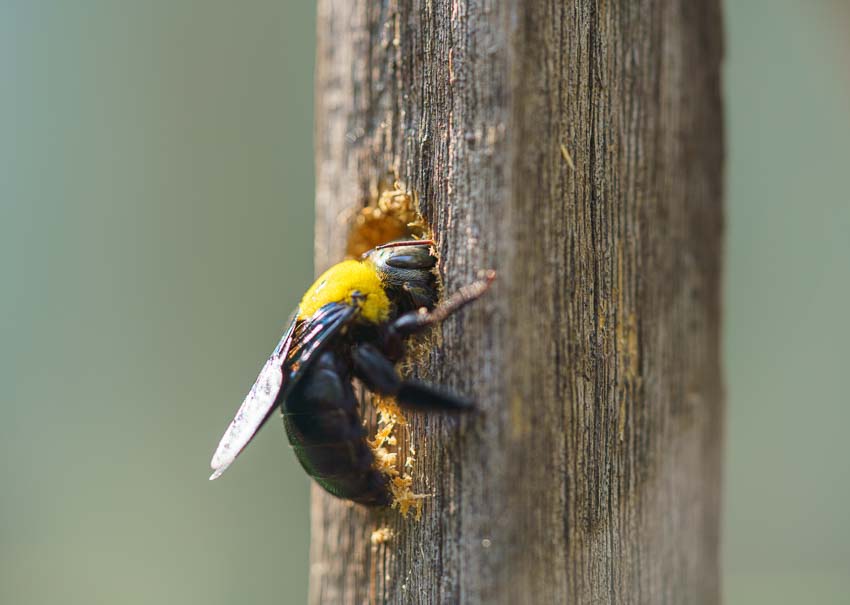Carpenter bees are important beneficial pollinators, but they cause damage by boring holes into wood, weakening the structure of your home and causing an unsightly mess. Learn how to get rid of carpenter bees and win the battle against them with these effective strategies.
Unveiling the Enemy: Understanding Carpenter Bees
When most people think of bees, they think of hives and honey. However, unlike honey bees, 90% of bees are solitary, including carpenter bees. They make their own nests, called galleries, and live alone, surviving through the winter in the tunnels they bore in the wood.
Defining Characteristics of Carpenter Bees
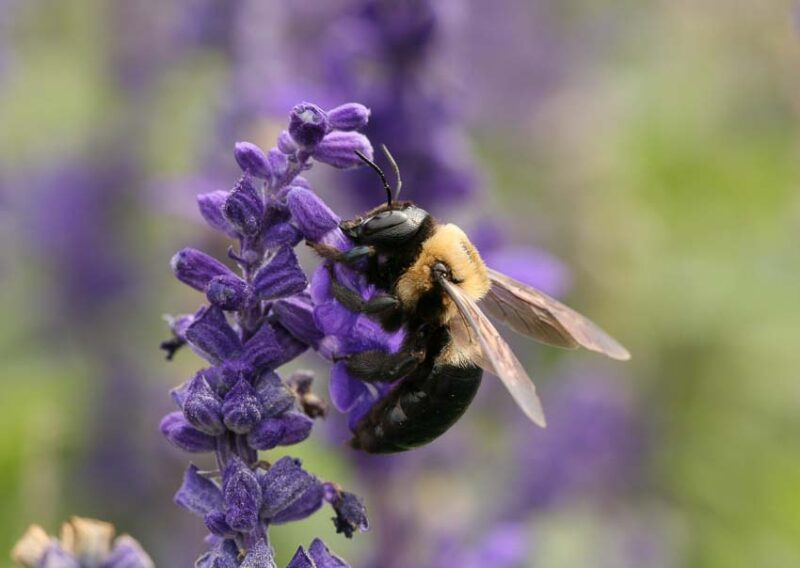
There are over 500 species of carpenter bees in the genus Xylocopa. Understanding them will help you to get rid of them.
Their scientific name comes from the Greek word meaning “woodcutter.” Several other names, including termite, wood boring, and wood bee, also know them.
Carpenter bees closely resemble bumble bees, another type of solitary bee. Both species are black and yellow and about an inch long. However, a carpenter bee’s abdomen is shiny and black, while the bumble bee’s rear end is covered with fuzzy yellow hairs.
Another major difference between carpenter bees and bumble bees is the stinger. All bumble bees have stingers, but only the female carpenter bee has a stinger. Carpenter bees usually aren’t aggressive, even though the males will sometimes swarm you and act in a threatening manner as their only defense to protect their territory.
Carpenter bees come to your yard in search of food and shelter. In particular, they like untreated wood that they can bore into and make a nest, but they don’t eat it. Carpenter bees feast on pollen and nectar from flowers like many bees and wasps, but they don’t produce honey.
Carpenter Bees: Important Pollinators
You might be wondering what the buzz is all about if you’ve ever heard a carpenter bee while they are collecting pollen. Like bumble bees, carpenter bees use buzz pollination to gather pollen from certain types of flowers that other pollinators can’t get to.
When they land on a flower, carpenter bees and bumble bees rapidly vibrate the wing muscles in their thorax (chest region). This shakes the pollen loose from the anther, which is part of the flower that produces pollen.
Only a few types of insects use his method of pollination, also known as sonication. This is how over 20,000 plants are pollinated, including many important food crops. Some flowers, including Passiflora incarnata and Orphium, are only pollinated by carpenter bees, making them important pollinators.
The Lifecycle of Carpenter Bees
The lifecycle of carpenter bees also plays a role in knowing how to get rid of them. They usually live about a year, but they can live up to three years. They produce one or two generations per year, undergoing a complete metamorphosis in four stages: egg, larva, pupa, and adult.
Carpenter bees are active in early spring, boring holes in untreated wood, approximately ½” in diameter and up to two inches deep. Once they are in, their tunnel takes a sharp turn, and they continue excavating their gallery for about four to eight inches.
Inside the gallery, the female creates partitions for brood cells and places a food ball in each one. Then, she lays her eggs and closes the cells off with regurgitated wood.
The food ball, which is made of pollen and nectar, sustains the larva until it’s ready to pupate. After she lays her eggs, the female carpenter bee dies.
When young adult carpenter bees emerge from the pupal stage, they stay in the gallery for several weeks. In the fall, the galleries are empty after they move out, which is the best time to plug their holes to keep them from re-entering.
Adult carpenter bees overwinter in the galleries; when spring comes, the ones that survived the winter find a mate and lay eggs. Carpenter bees use pheromones to return to the same gallery every year. They often reuse the same holes but will also drill new ones in the same piece of wood.
Detecting Carpenter Bee Activity in Your Home
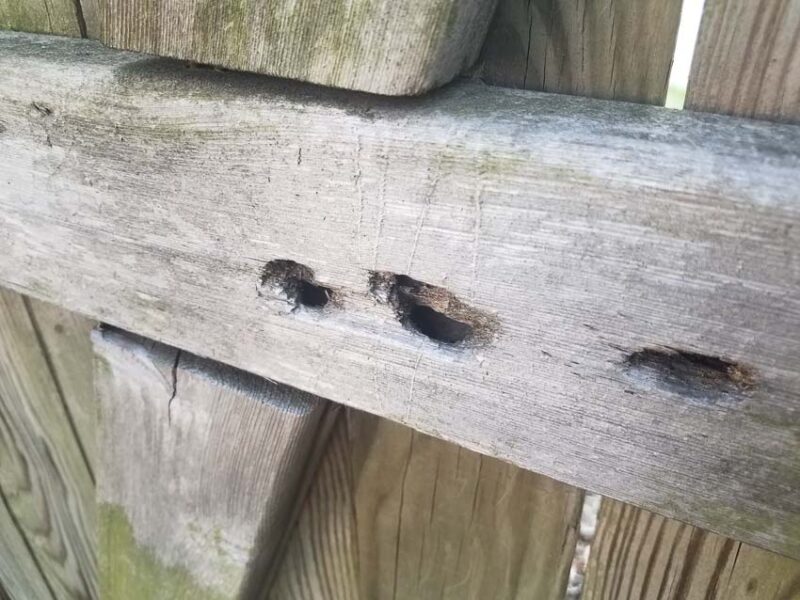
While they might be important beneficial pollinators, carpenter bees are annoying pests when they make their nests in your house. Learn more about the telltale signs and discover how to assess the extent of carpenter bee damage.
Telltale Signs of Carpenter Bees
In creating our guide on how to get rid of carpenter bees, we also discovered that seeing them flying around or hovering near untreated wood on the exterior of your house is the first sign of their activity. They are attracted to untreated wood of all kinds, especially softwoods, and will try to nest in any of the following areas:
- Exterior siding
- Window sills
- Eaves
- Rafters
- Fascia
- Shake roofs
- Decks
- Porches
- Fences
- Outdoor furniture
Once they start boring into wood, you will see more signs of carpenter bee activity, which include piles of sawdust and round holes in wood. Sometimes, you can even hear them buzzing in the walls of your house.
Assessing the Extent of Damage
Damage caused by carpenter bees includes the unsightly excrement from the holes they bore and, of course, the holes themselves. The holes that carpenter bees drill into wood range from the size of a pencil eraser to as large as a penny.
The holes are usually clean and smooth, and sometimes there is no sawdust because the female uses it to create the partitions for her brood cells. The gallery tunnels can compromise the structure of the wood.
Woodpeckers are attracted to the holes of carpenter bees and are one of their main predators. Woodpeckers will create larger holes to get to the bee larvae and can cause extensive damage to the exterior of your house or a wood shake roof.
Methods to Get Rid of Carpenter Bees
For the most part, carpenter bees are harmless. They’re busy working and minding their own business and don’t cause serious damage like termites. It’s critical to remember that carpenter bees are important pollinators essential to growing food crops, and their numbers are already declining due to habitat reduction.
However, if you have a lot of them at your house, carpenter bees can cause enough damage to be a problem. The secondary damage caused by woodpeckers is usually worse and spurs many homeowners to take action to get rid of carpenter bees.
Non-Chemical Solutions
This guide on how to get rid of carpenter bees also explores the best natural solutions to get rid of carpenter bees without using harsh chemicals.
Method #1: Natural Spray
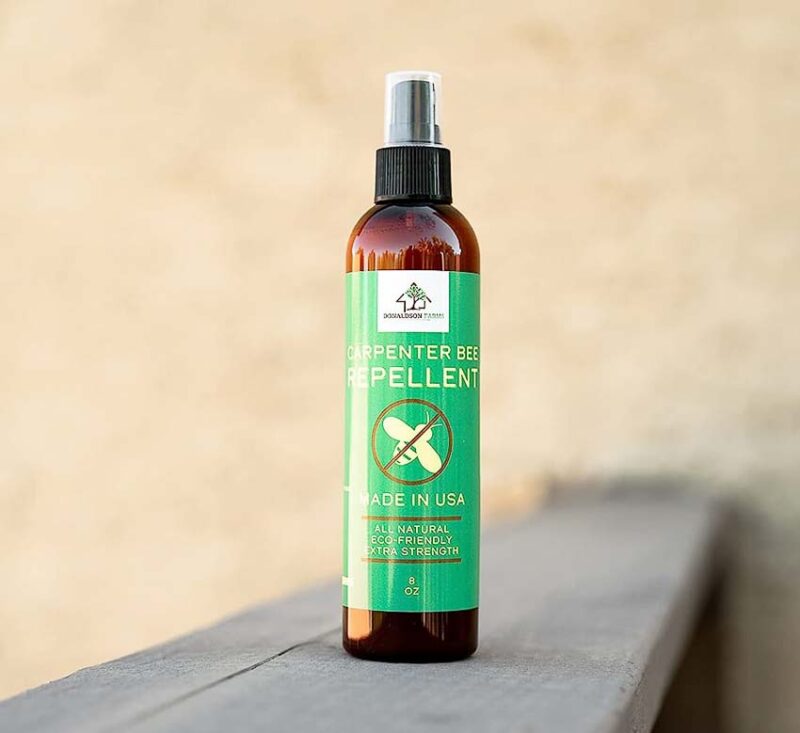
You can purchase ready-to-use natural sprays to deter carpenter bees or make your own with a citrus essential oil. Donaldson Farms Carpenter Bee Repellent Spray and Vine Homecare Bee Control Spray are two top choices for an all-natural solution to your carpenter bee problem.
Method #2: Use Sound
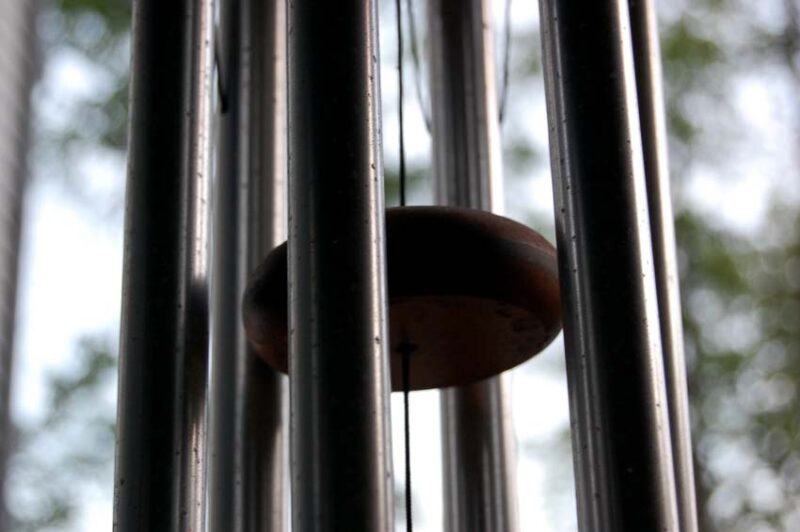
You can deter carpenter bees with sound, or rather, with the vibrations that create sounds. Carpenter bees are sensitive enough that putting speakers next to the wall of your house where they are trying to nest will drive them away.
You can also use wind chimes on your porch, especially if the neighbors are likely to complain about loud music.
Method #3: Traps
You can make your own or purchase carpenter bee traps, either online or at home improvement stores. The best carpenter bee traps are made out of wood and have a ½” hole that bees can enter. Some of them use baits like carpenter ant attractant, but most of them are effective without it.
Once in the trap, carpenter bees won’t be able to escape, and you can choose to release them somewhere else if you don’t want to kill them. Hang the trap above the area where they are drilling into wood. They’ll go in, thinking it’s a nesting place.
Method #4: Vinegar Solutions
Vinegar sprays are one of the least expensive and easiest ways to get rid of carpenter bees without killing them. Use one part household vinegar to one part water, and spray it wherever carpenter bees are a problem. The vinegar disrupts their pheromones and repels them.
Method #5: Plug Holes
The best time to plug the holes carpenter bees make is early fall. The gallery is no longer used to raise young carpenter bees; adults haven’t moved in yet for the winter. Plug the holes they made with pieces of steel wool and caulk, and treat the wood with paint or a wood stain and sealer.
Chemical Solutions
You can resort to chemical solutions for a quick and easy method to kill carpenter bees. Spray insecticides will get rid of carpenter bees quickly, but remember that they are valuable pollinators, and it’s better to repel them than kill them.
Insecticides

Spray foam insecticides work well because they expand to fill the hole and kill any bees inside the gallery. BioAdvanced Termite and Carpenter Bee Killer Plus Foam is an effective carpenter bee spray and will kill carpenter bees on contact. It also works on termites.
WD40
You can use a can of WD40 to kill individual carpenter bees or spray inside their holes. It not only kills them on contact, but it also destroys the pheromones that attract other carpenter bees and prevents their return.
Prevention: Key Strategies to Deter Carpenter Bees
Prevention is the key to dealing with carpenter bee problems. You can avoid killing these beneficial pollinators with simple habitat modifications and regular property maintenance.
Habitat Modification
Treating the wood on your house and regularly using natural sprays and repellents will keep carpenter bees from nesting there.
One of the best ways to keep carpenter bees from making their homes inside your home’s walls, porch railings, and eaves is to create a carpenter bee habitat. Use untreated, weathered wood, which they prefer, and pre-drill ⅜” holes to encourage them to nest there.
With this method, you don’t have to worry about killing them, and you’ll still have carpenter bees around to pollinate the plants in your garden.
Regular Maintenance and Monitoring
Carpenter bees prefer untreated, weathered wood, so the simple solution is to paint, stain, and seal the wood on your property so it isn’t attracting carpenter bees. Before painting, fill the natural gaps and holes to make the wood even less attractive to them.
Stuff steel wool into existing carpenter bee holes and seal them with caulk. You can paint over the holes to improve the appearance of the wood.
Keep all of the wood on your property maintained. Most wood on the exterior of your house, like window trim and fascia boards, needs to be repainted every three to five years, depending on the weather and how much sun it gets.
How to Rid of Carpenter Bees FAQs
Are Carpenter Bees Dangerous?
Carpenter bees are not dangerous. They are generally considered docile and anti-social, but mostly, they are too busy working to notice you. They aren’t mean like some types of wasps, and male carpenter bees don’t even have a stinger. If you do have one flying around you in a threatening manner, it’s probably a male. Since they can’t sting, acting threatening is their only defense.
Do Carpenter Bees Sting?
Female carpenter bees can sting, but it’s rare, and they won’t sting without provocation. Males may swarm you and act in a threatening manner, but they don’t have a stinger, so it’s all bluster.
How to Repair Damage Caused by Carpenter Bees?
Wait until early fall to plug the holes caused by carpenter bees because that’s when the nests aren’t being used. If the carpenter bee damage is bad enough, or there is structural damage, you may have to replace some wood, but usually, you can fill it with caulk or wood putty and paint over it.
What Attracts Carpenter Bees to My Home?
Carpenter bees are attracted to food and shelter, which means flowers and untreated wood. Never leave the wood on your buildings untreated, including porches, sheds, and fences.
Are There Beneficial Aspects of Carpenter Bees?
Carpenter bees are important beneficial pollinators. They are one of only a few types of insects that use sonification, also known as buzz pollination, to pollinate over 20,000 types of plants. About 35% of the world’s food crops rely on insects for pollination, so even though they can be annoying, they are critical to human survival.
Got other pests to get rid of? Check out our guides to deer, mice, groundhogs, raccoons, rabbits, stray cats, slugs, ticks, aphids, ants, and plants that repel mosquitoes!

